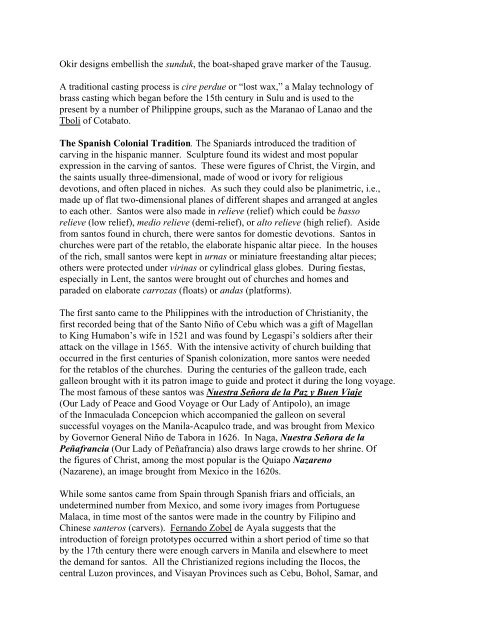SCULPTURE Sculpture is the art of making three-dimensional ...
SCULPTURE Sculpture is the art of making three-dimensional ...
SCULPTURE Sculpture is the art of making three-dimensional ...
You also want an ePaper? Increase the reach of your titles
YUMPU automatically turns print PDFs into web optimized ePapers that Google loves.
Okir designs embell<strong>is</strong>h <strong>the</strong> sunduk, <strong>the</strong> boat-shaped grave marker <strong>of</strong> <strong>the</strong> Tausug.<br />
A traditional casting process <strong>is</strong> cire perdue or “lost wax,” a Malay technology <strong>of</strong><br />
brass casting which began before <strong>the</strong> 15th century in Sulu and <strong>is</strong> used to <strong>the</strong><br />
present by a number <strong>of</strong> Philippine groups, such as <strong>the</strong> Maranao <strong>of</strong> Lanao and <strong>the</strong><br />
Tboli <strong>of</strong> Cotabato.<br />
The Span<strong>is</strong>h Colonial Tradition. The Spaniards introduced <strong>the</strong> tradition <strong>of</strong><br />
carving in <strong>the</strong> h<strong>is</strong>panic manner. <strong>Sculpture</strong> found its widest and most popular<br />
expression in <strong>the</strong> carving <strong>of</strong> santos. These were figures <strong>of</strong> Chr<strong>is</strong>t, <strong>the</strong> Virgin, and<br />
<strong>the</strong> saints usually <strong>three</strong>-<strong>dimensional</strong>, made <strong>of</strong> wood or ivory for religious<br />
devotions, and <strong>of</strong>ten placed in niches. As such <strong>the</strong>y could also be planimetric, i.e.,<br />
made up <strong>of</strong> flat two-<strong>dimensional</strong> planes <strong>of</strong> different shapes and arranged at angles<br />
to each o<strong>the</strong>r. Santos were also made in relieve (relief) which could be basso<br />
relieve (low relief), medio relieve (demi-relief), or alto relieve (high relief). Aside<br />
from santos found in church, <strong>the</strong>re were santos for domestic devotions. Santos in<br />
churches were p<strong>art</strong> <strong>of</strong> <strong>the</strong> retablo, <strong>the</strong> elaborate h<strong>is</strong>panic altar piece. In <strong>the</strong> houses<br />
<strong>of</strong> <strong>the</strong> rich, small santos were kept in urnas or miniature freestanding altar pieces;<br />
o<strong>the</strong>rs were protected under virinas or cylindrical glass globes. During fiestas,<br />
especially in Lent, <strong>the</strong> santos were brought out <strong>of</strong> churches and homes and<br />
paraded on elaborate carrozas (floats) or andas (platforms).<br />
The first santo came to <strong>the</strong> Philippines with <strong>the</strong> introduction <strong>of</strong> Chr<strong>is</strong>tianity, <strong>the</strong><br />
first recorded being that <strong>of</strong> <strong>the</strong> Santo Niño <strong>of</strong> Cebu which was a gift <strong>of</strong> Magellan<br />
to King Humabon’s wife in 1521 and was found by Legaspi’s soldiers after <strong>the</strong>ir<br />
attack on <strong>the</strong> village in 1565. With <strong>the</strong> intensive activity <strong>of</strong> church building that<br />
occurred in <strong>the</strong> first centuries <strong>of</strong> Span<strong>is</strong>h colonization, more santos were needed<br />
for <strong>the</strong> retablos <strong>of</strong> <strong>the</strong> churches. During <strong>the</strong> centuries <strong>of</strong> <strong>the</strong> galleon trade, each<br />
galleon brought with it its patron image to guide and protect it during <strong>the</strong> long voyage.<br />
The most famous <strong>of</strong> <strong>the</strong>se santos was Nuestra Señora de la Paz y Buen Viaje<br />
(Our Lady <strong>of</strong> Peace and Good Voyage or Our Lady <strong>of</strong> Antipolo), an image<br />
<strong>of</strong> <strong>the</strong> Inmaculada Concepcion which accompanied <strong>the</strong> galleon on several<br />
successful voyages on <strong>the</strong> Manila-Acapulco trade, and was brought from Mexico<br />
by Governor General Niño de Tabora in 1626. In Naga, Nuestra Señora de la<br />
Peñafrancia (Our Lady <strong>of</strong> Peñafrancia) also draws large crowds to her shrine. Of<br />
<strong>the</strong> figures <strong>of</strong> Chr<strong>is</strong>t, among <strong>the</strong> most popular <strong>is</strong> <strong>the</strong> Quiapo Nazareno<br />
(Nazarene), an image brought from Mexico in <strong>the</strong> 1620s.<br />
While some santos came from Spain through Span<strong>is</strong>h friars and <strong>of</strong>ficials, an<br />
undetermined number from Mexico, and some ivory images from Portuguese<br />
Malaca, in time most <strong>of</strong> <strong>the</strong> santos were made in <strong>the</strong> country by Filipino and<br />
Chinese santeros (carvers). Fernando Zobel de Ayala suggests that <strong>the</strong><br />
introduction <strong>of</strong> foreign prototypes occurred within a short period <strong>of</strong> time so that<br />
by <strong>the</strong> 17th century <strong>the</strong>re were enough carvers in Manila and elsewhere to meet<br />
<strong>the</strong> demand for santos. All <strong>the</strong> Chr<strong>is</strong>tianized regions including <strong>the</strong> Ilocos, <strong>the</strong><br />
central Luzon provinces, and V<strong>is</strong>ayan Provinces such as Cebu, Bohol, Samar, and

















